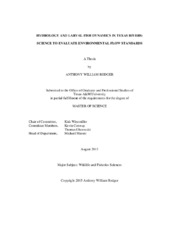| dc.description.abstract | Given increasing human demands for freshwater, it is imperative to identify environmental flows that maintain native species, their habitats, and key ecosystem dynamics. A major challenge is determining requirements for seasonal flow pulses that promote fish spawning, early life stage survival, dispersal, and other processes that maintain native stocks. Our study investigated hydrology, fish reproduction, larval abundance, survivorship, and community assemblage of larval fish in both the lower Brazos and middle Trinity rivers in Texas and the littoral fish assemblage in the lower Brazos River. From March 2013 to March 2014, abiotic environmental data were collected along with data on fish abundance, reproduction, and recruitment. Larval fish were collected bimonthly at night using three arrays of stationary driftnets arranged along transects perpendicular to the shoreline. Seine nets were used to sample fish assemblages in shallow littoral habitats. Asteriscus otoliths, from metalarvae and juvenile Macrhybopsis hyostoma, were removed and patterns between hatch date estimates and discharge were analyzed to determine if recruitment was related to streamflow.
Multivariate statistical analyses based on seine samples revealed that discharge significantly explained variation in the littoral fish assemblage in the Brazos River. In both the Brazos and Trinity Rivers, multivariate analyses of driftnet data indicated that water temperature had the strongest association with patterns of larval fish abundance, based on evaluations at the family level. Cyprinid protolarvae, in aggregate, did not seem to be constrained by hydrology, as evidenced by their high abundance throughout the reproductive season (April–September). Hatch dates from surviving Macrhybopsis hyostoma indicated that recruitment was greater on flow pulses and on days with increasing discharge. Ongoing work to identify larval fish to species level is needed to elucidate how flow regime components influence reproduction and recruitment of fluvial specialists. This information will significantly augment our currently limited knowledge of the life histories of minnows inhabiting Gulf coastal rivers, which in turn will assist in evaluating environmental flow regimes. | en |


